General Mills could make Easter-themed Lucky Charms with all the holiday’s symbols. The jingle practically rewrites itself: lamb, fish, and rabbits; pastel eggs in baskets; butterflies, palm branches; and some hot cross buns!
And then there’s the Easter lily.
Attend an Easter service anywhere in North America, and you’re bound to see white, trumpet-like flowers anchoring the floral arrangements, or at least pick up their strong perfume. Also known as Bermuda lilies, or Lilim longiflorum to the horticultural crowd, Easter lilies became the go-to flower for the spring holiday on American shores in the 20th century. Yet the lily’s ties to Christianity were established long before.

